Dr. Fukunaga talks on India-Japan Relationship – Buddhism, Swami Vivekanand & path ahead
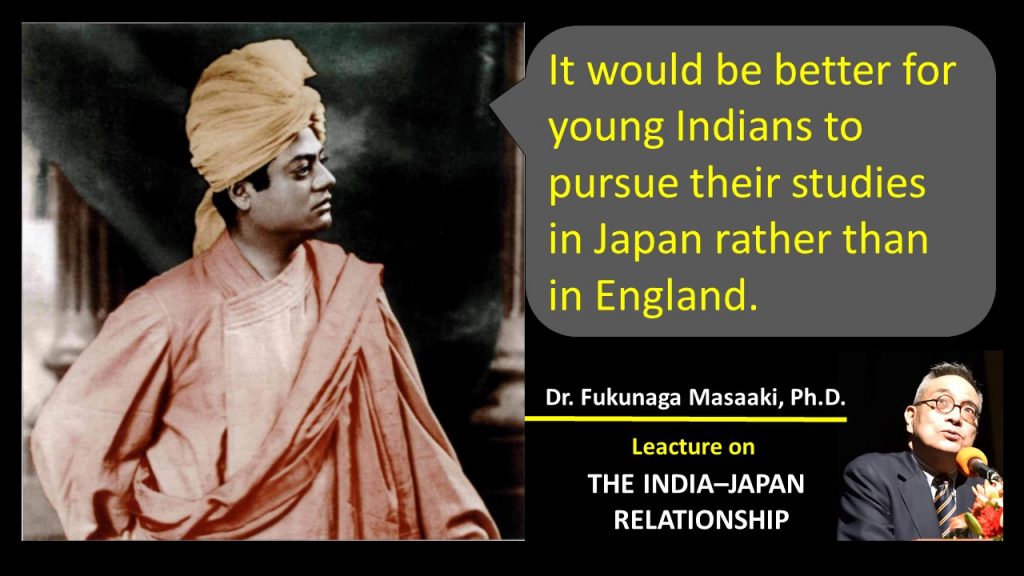
In his talk, Dr. Fukunaga Masaaki, Ph.D. covered the brief social history of both Japan and India, right from the time when Buddhism entered Japan, Meiji era, the era of colonization in India, post-WW2 & post-independence of India, and emphasizes that India-Japan relationship has been great but there is a need to know more about each other, in detail. You can read the whole lecture as PDF, below these excerpts.
Dr. Fukunaga sees India-Japan relationship as “mutual misjudgment of goodwill.” He says ” There is no preconceived malice or ill will on either side, and each has a good impression of the other. For example, in Japan, whenever we recall India, the images that arise within our minds are linked to the growth of IT (Information Technology), people skilled in mathematics, delicious Indian curry, and so on, while in the case of India, whenever Indians recall Japan, they promptly visualize images of a society bouncing back from the ravages of the atomic bomb, brand name products of cutting-edge technology, and so on.”
Dr. Fukunaga Masaaki, Ph.D. spoke on the occasion of the 155th birth anniversary of Swami Vivekananda and the topic was close to his heart “India-Japan Relationship”. For Fukunaga-san, India is not a new topic since In 1981, for a period of 3 he studied at Benaras Hindu University and obtained Ph.D. in Sociology. He spent around a year in a farming village and conducted observational research as fieldwork which earned him a doctorate which also got published in Delhi and London.
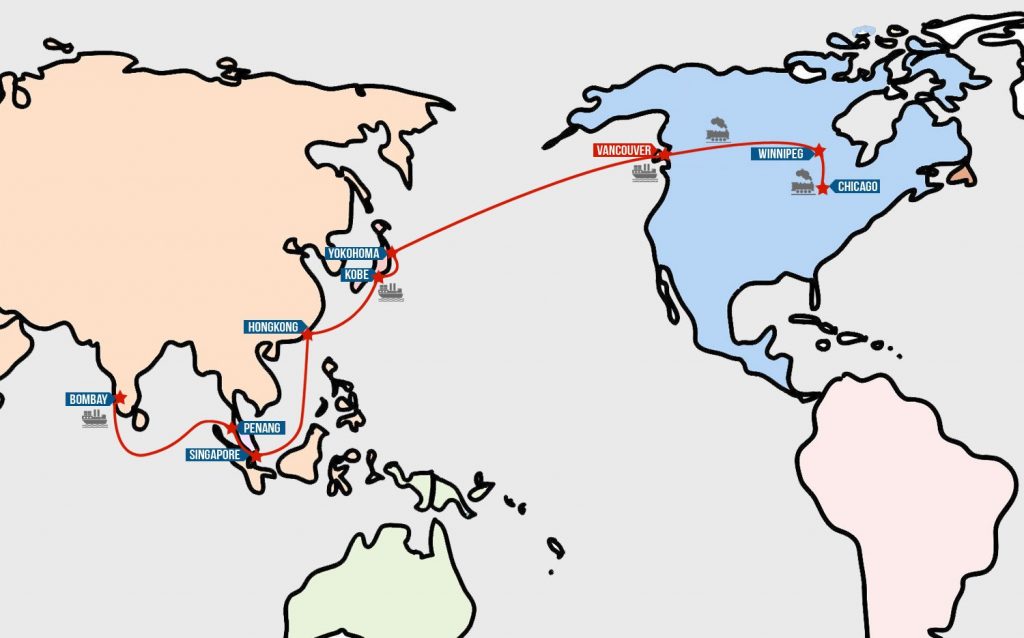
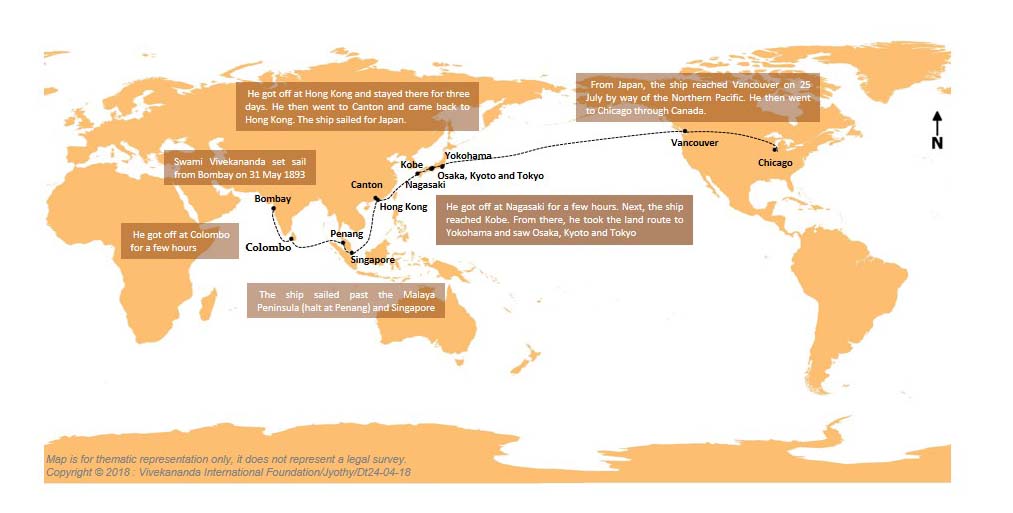
- For example, during an interview that he gave for a Chennai newspaper in February 1897, he declared:
- Japanese have a great sense of loyalty and love for their nation, even to the extent of sacrificing everything for it.
- Their Art is authentic.
- The Buddhism they follow, namely the Mahayana school of Buddhism, differs from the Theravada Buddhism of Ceylon (the former name of Sri Lanka). It is atheistic and positive Buddhism, similar to Vedanta.
- Japan seeks to absorb deeply the wisdom of the West, while at the same time sustaining its own spirituality.
- Japanese eat optimal amounts of cooked rice and miso soup.
- It would be better for young Indians to pursue their studies in Japan rather than in England.
When Japan thinks about India, the thoughts turn invariably to e ‘Land of Buddhism,’ , or the ‘land that created curry rice,’ and so on and so forth. In recent times India`s image as information Technology, huge consumer market, sustained by the sustainable population, a land of prodigies capable of the efficient use of 4-digit arithmetic and also connected with Japan in areas related to regions security.
Nonetheless, however, present-day Indian society and its people are issues that are almost wholly unknown to the average Japanese. This perhaps is due to the fact that in 21st century India, poverty and economic growth are intermingled, and this, in turn, has given rise to an excessively complex form of society along with a multiplicity of the co-existence of religions & faith. These are the matters which are hard for Japanese people find hard to fathom.
Buddhism which originated in India, entered Japan in the 6th century, the Japanese people referred to India as ‘Tenjiku,’ and it was looked upon as a nation that one yearned for. Tenjiku was the Japanese version of the Chinese word “Tianzhu” which was transliterated from old Persian “Hinduka” which originated from the word “Sindhu”, Sanskrit version of the Indus River. So Sindhu-> Hindu -> Tianzu -> Tenjiku.
Also, the South Indian Buddhist monk Bodhisena arrived in Japan from ‘Tenjiku’ in the 8th century after journeying through China, and he performed the eye-opening ceremony for the giant bronze statue of Buddha Mahavairocana in the Tōdaiji Temple, located in the city of Nara.
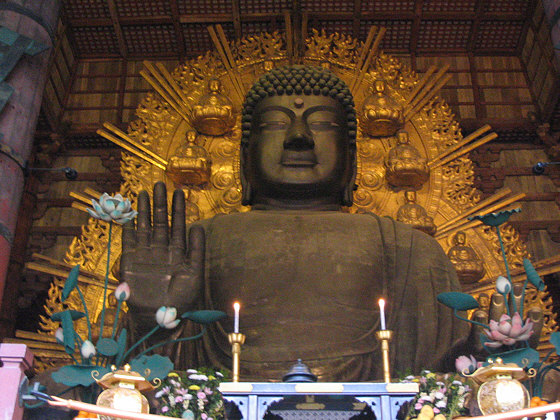
“Tenjiku Dream”
This yearning that people had for Tenjiku, the birthplace of Buddhism, was fostered by hymns that extolled it as the most ideal place on earth. Furthermore, it underscored the fact these three nations, namely Tenjiku, China, (which had created an outstanding culture), and Japan, were especially linked to one another, and hence this longing for Tenjiku even pervaded the ranks of the common man.
“Japan didn`t know real India”
What is clear to us is that as regards Tenjiku or India, from the remote past to modern times, the thoughts of the Japanese were focused not so much upon the hardships that pervaded the society and livelihood of the Indians. Rather, they were focused more upon this feeling of yearning for India, something that was far removed from the reality that pervaded the place.
“The hardships in India during colonization”
In the middle of the 19th century, during the Meiji Restoration that followed the re-opening of Japan to the world, many young Japanese sailed to Europe, and in the course of their voyage some stopped by in India. This was not merely due to their interest in India as a land sacred to Buddhism. Rather, for those who were sailing to Europe with high expectations of acquiring knowledge from the West, India projected an image that was quaint and curious. That is to say, for academics and young intellectuals of Japan, a nation that had just begun to embark upon the path to modernism, India appeared to be a nation writhing under the torment of colonialism, a pitiful nation mired in poverty and gasping under oppression. It was thus that Tenjiku, which for long had served as an object of yearning for vast numbers of Japanese, now came to be viewed as a victim of Western colonialism, a nation undergoing the agonies of penury and destitution.
“The Changed Outlook”
In fact, after the Meiji Restoration there arose a change in Japan’s outlook, as conveyed by the words, “we should not become like India.” Additionally, such changes also gave rise to the reaction that Japan should endure as a nation of Asia, that was strong enough to resist the Western colonial powers. It was precisely at that time that Swami Vivekananda chose to visit to Japan, and his visit turned out into becoming an event of critical value for both nations.
Sad to say though, ideas of nationalism began to be emphasized in Japanese society, and in due course the hand of invasion began to be stretched out towards Asia, including towards India, the land of yearning.
“Tagore connection”
In the early 20th century, Nobel Laureate, Rabindranath Tagore, visited Japan on five separate occasions. He introduced Indian culture to the scholarly elite of Japan and commenced a fresh cultural exchange between Japan and India, an exchange that was not limited to Buddhism.
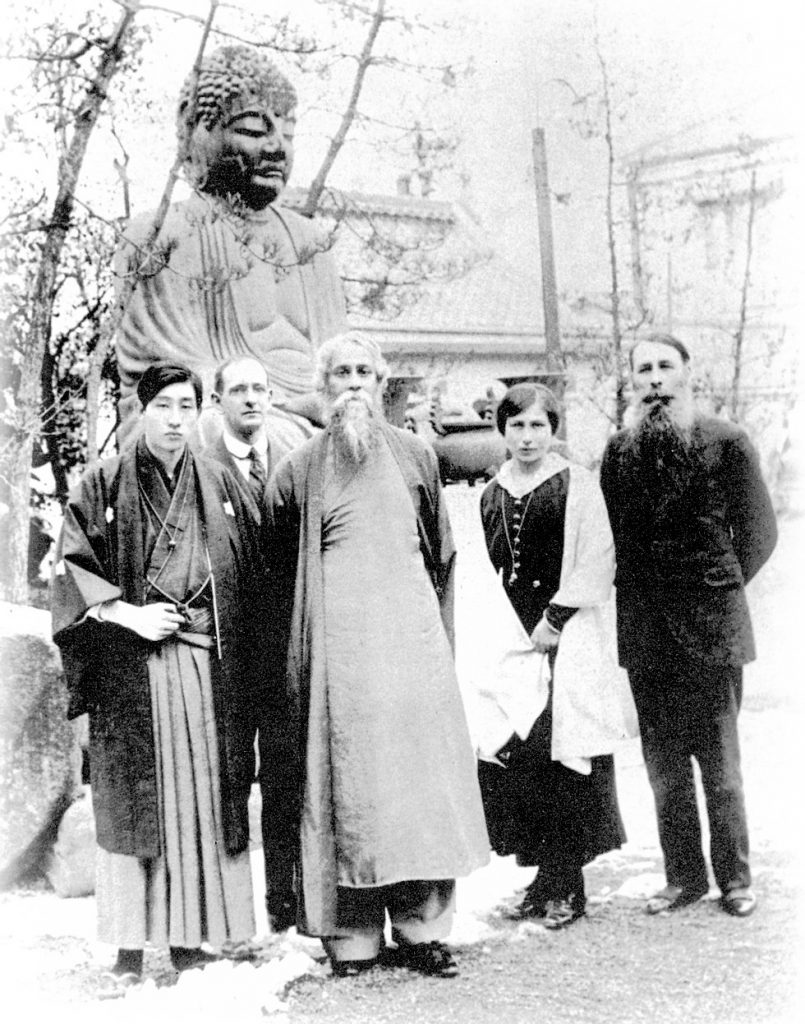
“Mahatma Gandhi`s approach of non-violence & Japan in that era”
Aside from providing a spiritual boost to the independence movement and defying the colossal British Empire, Mahatma Gandhi was an individual who was accepted by the Japanese people with feelings of profound awe. In Japan, a nation that was nursing designs of launching a counter-offensive against Western control and thereby becoming a spokesperson for Asia, Gandhi became a new target of esteem, and his role as an Asian who would defy the West, was highlighted.
In actual fact Gandhi’s notions of non-violence and civil disobedience were promptly translated and conveyed to the Japanese, but on gauging the issue, we may perhaps say that the people associated with the society and press of those days, were unable to acquire a suitable grasp of what those notions implied. That is to say, while promoting the liberation of the Asian People from the hegemony of the West, Japan to the very end, set its sight upon attaining in an expedient manner, both the freedom of the Asian People, and the overthrow of Western Imperialism. It is also clear that once this Western control was toppled, the plan was for Japan itself to occupy their place.
In reality however, Japan, which was proactively endorsing the subjugation of Asia, went on to invade British India, modern India, Bangladesh, and Myanmar (Burma). As regards relations between India and Japan at that time, there is little indication of adverse history. However, that was merely due to the fact that it was an issue that was never raised, as it was considered bad for both nations. Even so however, it is undeniably a portion of history that we should never forget.
“Dr. Radha Binod Pal”
In the aftermath of the Second World War India gained independence from Great Britain in 1947, and thereafter, all its policies towards Japan, which was now an occupied country exhausted by defeat, exerted a forceful impression upon the Japanese public. Certain initiatives taken by India, as for example at the International Military Tribunal for the Far East, the insistence of Dr. Radha Binod Pal of India that the trial should be declared invalid on the basis of the principle of legality, India’s refusal to participate in the San Francisco Peace Conference of 1951 as a sign of protest against the continued presence of foreign troops (the US army) in Japan, the separate peace treaty signed between India and Japan, and other similar moves, all led to a brightening of the prospects of Independent India.
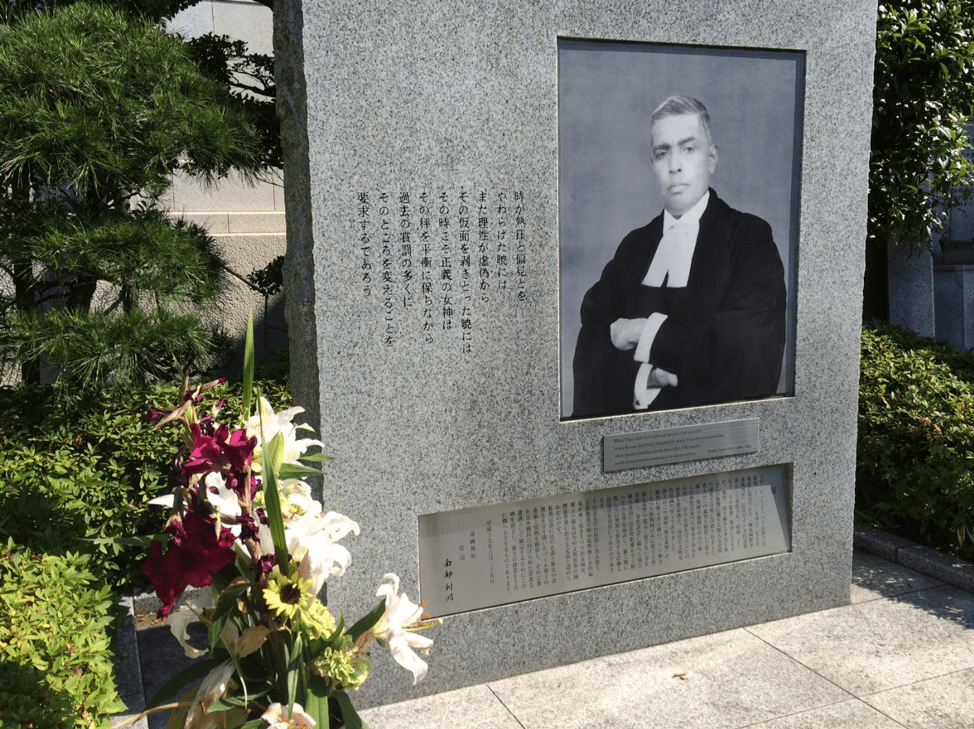
It is obvious that for India, which after gaining independence had promptly acquired the awareness of its being a great nation, all such policies were purely a reaction against the Western powers. Such efforts of India, regardless of whether they stemmed from the colonial India of 1945 or the newly emerging India of 1947, evoked fresh reactions of goodwill among the Japanese, and the exultant welcome Prime minister Nehru received on his first visit to Japan in 1957, was emblematic of this. In Japan, sentiments of intimacy towards the great Indian nation were reinforced, feelings of yearning began to develop towards this new India, and one might even go so far as to say that regarding Indo-Japan relations,
the suitable keyword was “yearning.”
“Pro-soviet period of 1950-1991”
After 1950, India chose to adopt a pro-soviet stance, and this subsequently led to a distancing of itself from Japan. In actual fact though, until the collapse of the Soviet Union in 1991, relations between India and Japan were lethargic, and economic links remained torpid. The allure the Japanese had for India continued unabated, but now, more than Buddhist worship, they tended to view India as a place where people could travel freely, and where mutual accord was concerned, there seemed to be a dearth.
“Walk together & Learn from each other, in details”
Problems arise because people have a tendency to rely on these images alone, and not on the reality from which such images originate. The authentic state of society, the livelihood of the people, and other related issues are often ignored and not
conveyed to the other party, and this inevitably results in the failure of mutual cooperation, and an inability on our part to find solutions to our problems. More than looking for praise or adulation, what we are called upon to do is to struggle towards the attainment of the type of mutual relationship, that will counteract and offset such drawbacks and hurdles.
India is a huge nation, with a population increasing to massive proportions. It possesses a large consumer market, a thriving economy, and a youthful society of an average age of 27 years, which seems all set to expand even more. Japan on the other hand is an aging society, with a diminishing number of young people. Since its population is slated to decline in the years to come, the maintenance of its current industries and economic structures, the management of its society and so on, are issues that are likely to prove arduous in the coming decades. In view of this, it is essential these two nations reach out their hands to each other in a spirit of earnestness and discharge their roles as world leaders, especially with regard to the betterment of public welfare and protection of the environment
It is vital for both Japan and India to acquire an adequate perception of one another’s societies, peoples, and ideologies. The
spirit of ‘yearning’ alone will no longer serve to sustain bonds between them. The two need to learn from each other, exchange views, clarify issues on which they agree and differ, and assist one another for the benefit of both.
Recently there has been much debate concerning the relationship between India and Japan in connection with certain International Political Issues, namely, the relationship with China.
Dr. Fukunaga concludes by saying “What we need right now is for the people of India and Japan to learn from each other how to live as human beings, for this is what is demanded of us. Hence, for us who are members of Japan’s society, to learn from a reputed sage of the stature of Swami Vivekananda, is an issue of supreme significance. In addition, I desire that the Indian people persist in their efforts to acquire an insight into the culture of Japan, and I desire also that they look upon these efforts as a means to reflect upon and get to know better, their own culture as well”
Full Lecture of Dr. Fukunaga here in the PDF below:
PROF.-FUKUNAGA-ENG.End of post
Disclaimer: All thoughts in the lecture above are purely by Dr.Fukunaga and the whole purpose of this article is to preserve opinions on India and Japan for strengthening the cultural ties between the two countries. Please report to us if you find something offending or it is reproduced in some other meaning.
——Explore more on IndoJapanPulse Platform Ecosystem —-
Explore Japan and India on this premium curated info hub platform open for all
– Accessed from across the world who are interested in “Life in Japan”, Culture, Work, Business & beyond in Indo-Japan context
– Less Noise, more signal
– Community-focused useful info on Life, Work, Business, Startup & beyond
– Community-created posts encouraged
– No spams
Visit : http://indojapanpulse.com/
Subscribe to Youtube Page:
https://www.youtube.com/channel/UCwk4e_pL0o5eyUvkIC7cQZA/featured
Join Facebook Community:
https://www.facebook.com/groups/436167087220812/?ref=share
We can be reached at:
contact@IndoJapanPulse.com
————————————————
Leave a Reply to IndoJapanPulse
Please look at footer of website for Disclaimer and Privacy Policy.




